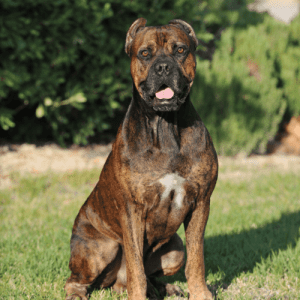
What Is The History Of The Alano Español Breed?
The Alano Español is a Spanish breed of dog used to hunt in the mountains and plains of Spain. The breed is believed to be descended from the Iberian Molosser, a type of Mastiff. The Alano Español was used by Spanish nobility and was also known as the “Spanish Alano” or “Spanish Bulldog.” The breed declined in popularity after the Spanish Civil War and was thought to be extinct by the 1970s. However, a small number of Alano Español were found in Spain, and the breed was revived. The Alano Español is still used for hunting and kept as a pet.
What Does An Alano Español Look like?
The Alano Español has a short, thick coat that is either brindle, fawn, wolf-sable, black & brindle, red or yellow in color. The jacket is coarse to the touch and sheds moderately throughout the year. Some individuals may have white markings on the chest, toes, or tail tip. The coat is easy to groom and only requires occasional brushing to remove loose hair.
How Big Is An Alano Español?
The Alano Español is a large breed of dog, with males weighing around 66 to 88 pounds and females averaging about 55 to 77 pounds. This breed is also very muscular, with a broad chest and strong legs. While there is some variation in size between individual dogs, Alano Españoles are generally larger than most other breeds of dogs. The Alano Español males measure 23 – 25 inches tall and females 22 – 24 inches tall.
Are There Other Dog Breeds Related To The Alano Español?
The Alano Español is related to the following dog breeds: American Bulldog, American Pit Bull Terrier, American Staffordshire Terrier, Bullmastiff, English Bulldog, French Bulldog, and Staffordshire Bull Terrier. These breeds share many common characteristics with the Alano Español, including a large and muscular build, a short coat, and a loyal and protective nature.
What Is The Life Expectancy Of An Alano Español?
The average lifespan of an Alano Español is 11-14 years. However, some individual Alano Españols have been known to live up to 15 years or more. The oldest recorded Alano Español was 18 years old. Factors that may influence the lifespan of an Alano Español include diet, exercise, environment, and genetics.
Can An Alano Español Be Trained?
The Alano Español is a very versatile breed that can be trained to do various tasks. They are used as working dogs in Spain, where they originated, but they can also be trained for other roles, such as service dogs, therapy dogs, and even companion animals. With their intelligence and eagerness to please, Alano Españoles are quick learners that make great pets for active families.
What Are Some Interesting Facts About An Alano Español?
1. The Alano Español is a large Molosser-type dog breed from the Iberian Peninsula.
2. The Alano Español is the result of crosses between the ancient Iberian Mastiff and the rare Spanish Bulldog.
3. The Alano Español was once used for bull-baiting and dog fighting but is now a loyal and gentle companion dog.
4. The Alano Español has a short, thick coat that comes in various colors, including brindle, fawn, black, and brown.
5. The Alano Español is an intelligent and trainable dog breed, making them an excellent choice for families and active individuals.
How Does An Alano Español Interact With People?
The Alano Español is a Spanish breed of dog known for being friendly and good with people. Because of their loving nature, good with children and other animals they make great family pets. They are also very intelligent dogs and train easily.
Alano Españols are typically amiable and loving dogs that enjoy being around people. These dogs have a calming effect on people and make them feel relaxed. Due to this these dogs are often used as therapy dogs.
